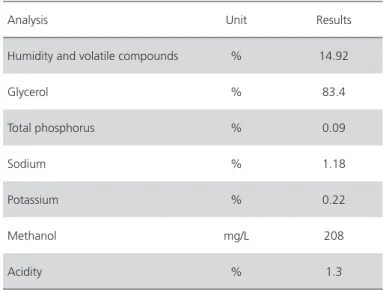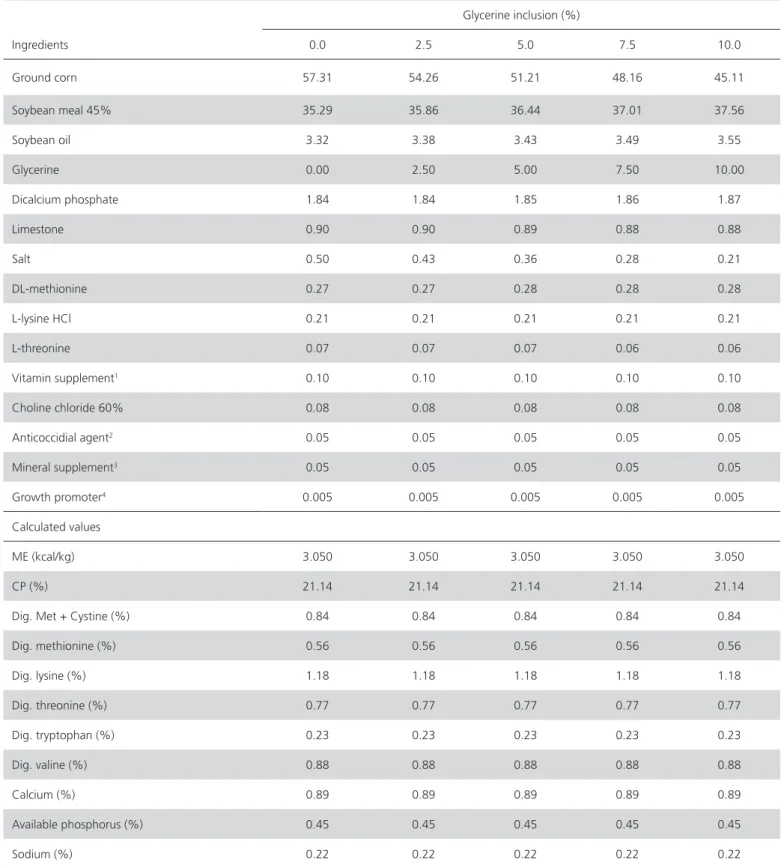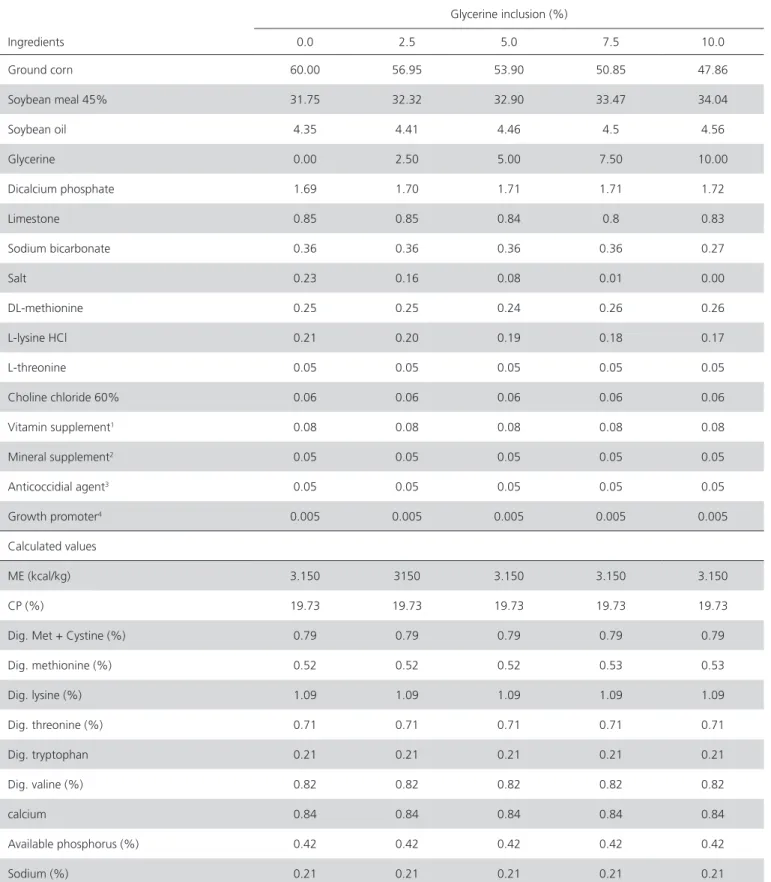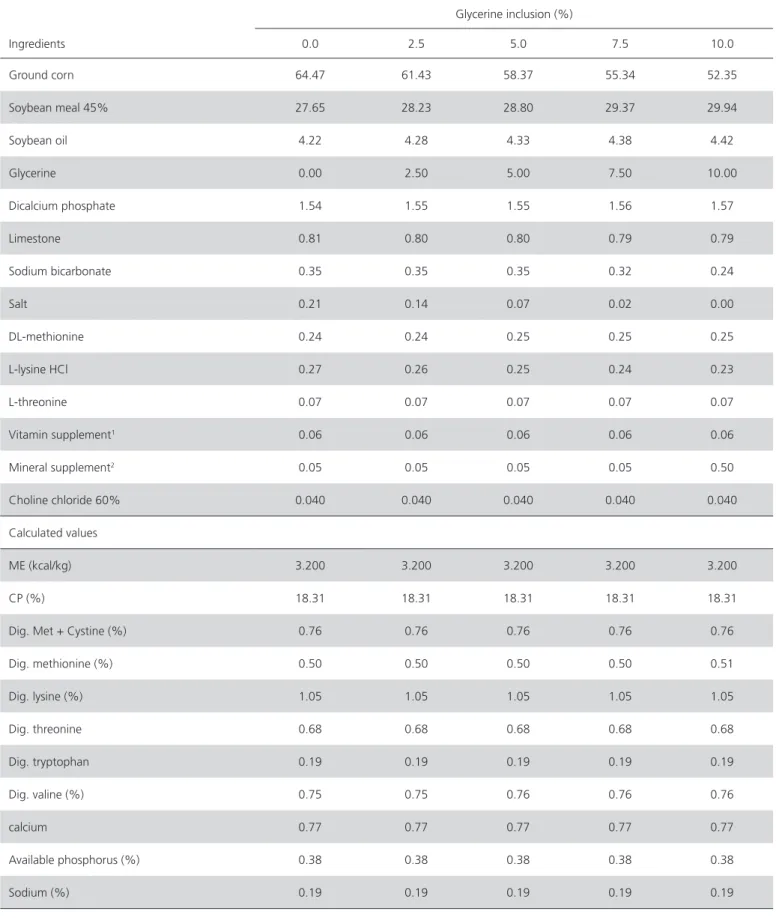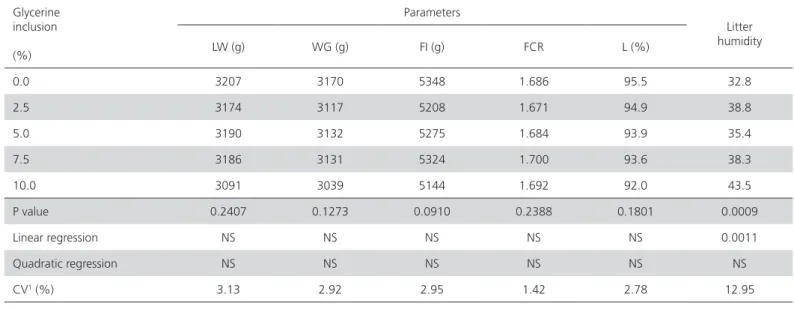ISSN 1516-635X Jul - Sept 2012/ v.14 / n.3 / 159-232
Feedstuff for Broiler Diets
Author(s)
Silva CLS2
Menten3 JFM
Traldi2 AB
Pereira2 R
Zavarize2 KC
Santarosa2 J
1 Part of the M.Sc. dissertation of the first
author. Part of the results of this study were published in the 2010 APINCO Conference proceedings (Nutrition Section), Santos, SP, Brazil
2 Graduate students – Department of Animal
Science - ESALQ/USP
3 Head Professor of the Department of Animal
Science - ESALQ/USP
Mail Adress
Camila Leão Silveira da Silva
Departamento de Zootecnia – ESALQ/USP Avenida Pádua Dias, nº11 – Agronomia –
Piracicaba – SP – CEP: 13418-900
E-mail: camilaleaos@yahoo.com.br
Keywords
Alternative feedstuffs, broilers, biodiesel, performance, glycerol.
Submitted: October/2011 Approved: August/2012
ABSTRACT
The performance, carcass traits, and litter humidity of broilers fed
increasing levels of glycerine derived from biodiesel production were
evaluated. In this experiment, 1,575 broilers were distributed according
to a completely randomized experimental design into five treatments
with seven replicates of 45 birds each. Treatments consisted of a
control diet and four diets containing 2.5, 5.0, 7.5, or 10% glycerine.
The experimental diets contained equal nutritional levels and were
based on corn, soybean meal and soybean oil. The glycerine included
in the diets contained 83.4% glycerol, 1.18% sodium, and 208 ppm
methanol, and a calculated energy value of 3,422 kcal AMEn/kg.
Performance parameters (weight gain, feed intake, feed conversion
ratio, live weight, and livability) were monitored when broilers were
7, 21, and 42 days of age. On day 43, litter humidity was determined
in each pen, and 14 birds/treatment were sacrificed for the evaluation
of carcass traits. During the period of 1 to 7 days, there was a positive
linear effect of the treatments on weight gain, feed intake, and live
weight gain. Livability linearly decreased during the period of 1 to 21
days. During the entire experimental period, no significant effects were
observed on performance parameters or carcass traits, but there was a
linear increase in litter humidity. Therefore, the inclusion of up to 5%
glycerine in the diet did not affect broiler performance during the total
rearing period.
INTRODUCTION
The denominations glycerine, glycerol, crude glycerine, and purified
glycerine are often interchangeably used, but these compounds may be
very different. The difference between the glycerine products available
in the market is determined by the intensity of their industrial processing.
They may be found in the crude (high fatty acid content), semi-purified
(low fatty acid content), or in the purified form (pure compound). The
by-product derived from biodiesel production has been called glycerol
by some authors, while others call it glycerine. However, according to
Morrison (1994), the term glycerol should be applied only to the pure
compound (1,2,3-propanetriol), whereas the term glycerine refers to
the purified commercial compounds.
Glycerine is the main co-product generated in the production of
biodiesel. Approximately 10% of the total volume of biodiesel produced
corresponds to glycerine (Dasari
et al.
, 2005). According to the Brazilian
Oil Agency, Brazil is among the largest global biodiesel producers and
consumers, with an annual production in 2010 of 2.4 biodiesel millions
liters, generating 240,000 tons of glycerine.
aspect that may justify the use of that co-product of
the biodiesel industry in feed production is that part of
the renewable raw materials used for energy purposes
will return to the food chain, generating products with
high nutritional value. In addition of being an energy
source, glycerol may also have positive effect on amino
acid or nitrogen retention, as mentioned by Cerrate
et
al.
(2006).
The energy value of glycerine is a function of its
proportion of pure glycerol (Lammers
et al.
, 2007b).
Research studies with broilers reported that the
coefficient of metabolization of gross energy (GEMC)
of glycerine products containing 85-90% glycerine
range between 95% (Dozier
et al.
, 2008) and 85%
(Gianfelici, 2009; Oliveira
et al.
, 2010), demonstrating
that broilers utilize this feedstuff efficiently .
In Brazil, recent studies carried out with poultry
(Gianfelici, 2009; Batista, 2010) and pigs (Berenchtein
et al.
, 2010) showed that glycerine may be included in
feeds, as it has high energy content and it is efficiently
used by animals.
The objective of this study was to evaluate the
influence on performance and carcass traits, as well
as possible detrimental effects, of increasing levels of
glycerine added as energy feedstuff in broiler diets.
MATERIAL AND METHODS
The study was carried out at the Department of
Animal Science of ESALQ/USP, Piracicaba, SP, Brazil.
A total number of 1,575 male Cobb 500 chicks, with
45.5g ± 3.3g average initial weight, were distributed
according to a completely randomized experimental
design into five treatments with seven replicates of 45
birds each.
The basal diet was formulated to supply the
broilers’ nutritional requirements, according to the
recommendations of Rostagno
et al.
(2005), and the
other four treatments consisted in the dietary inclusion
of 2.5, 5.0, 7.5, and 10% glycerine. Glycerine was
acquired from the company ADM do Brasil Ltda. and its
concentration was analyzed in a commercial laboratory
(Table 1). Glycerol concentration was determined by
high-performance liquid chromatography (HPLC),
with electro-chemical detection, according to the
methodology adapted from Silva (2004) and Dionex
Corporation (2006). The ingredient composition and
the calculated nutritional values are presented in Tables
2, 3, 4, and 5.
Glycerine gross energy value was determined
as 3,602 kcal/kg, using a calorimetric bomb. The
on Dozier
et al.
(2008), who determined that the
coefficient of metabolizability of glycerine gross
energy is 95%; therefore, the calculated metabolizable
energy was 3,422 kcal/kg. The apparent metabolizable
energy value (AME) was based on the study of Dozier
et al.
(2008), because the composition of the glycerine
products in both studies was similar. Diets were
formulated taking into account glycerine sodium and
chlorine levels.
The feeding program applied during the experiment
considered the following rearing phases: pre-starter,
from 1 to 7 days, starter, from 7 to 21 days; grower,
from 21 to 35 days, and finisher, from 35 to 42 days.
Birds were offered feed and water
ad libitum
during the
entire experimental period. Performance parameters
(live weight, weight gain, feed intake, feed conversion
ratio, and livability) were determined for each rearing
phase.
On day 43, two birds per experimental unit (14 birds
per treatment) were submitted to fasting for eight
hours, and then sacrificed to determine carcass yield
and parts (breast, drumstick + thighs, wings, and back)
yield, and abdominal fat content. Litter material was
collected from each pen to determine litter humidity.
Performance, carcass trait, and litter humidity data
were submitted to analysis of variance (ANOVA), using
the PROC MIXED of SAS (2006). When the effect of
glycerine levels was significant (p<0.05), degrees
of freedom were decomposed into their individual
components (linear and quadratic), using orthogonal
polynomials by the PROC REG of SAS (Statistical
Table 1
– Composition of the crude glycerine included in
the diets
Analysis Unit Results
Humidity and volatile compounds % 14.92
Glycerol % 83.4
Total phosphorus % 0.09
Sodium % 1.18
Potassium % 0.22
Methanol mg/L 208
Table 2
– Ingredient composition and calculated nutritional values of the pre-starter diets (1-7 days of age).
Glycerine inclusion (%)Ingredients 0.0 2.5 5.0 7.5 10.0
Ground corn 54.50 51.76 49.00 46.26 43.52
Soybean meal 38.59 38.89 39.21 39.51 39.82
Soybean oil 2.39 2.39 2.39 2.39 2.39
Glycerine 0.00 2.50 5.00 7.50 10.00
Dicalcium phosphate 1.94 1.94 1.95 1.96 1.97
Limestone 0.94 0.93 0.92 0.92 0.91
Salt 0.52 0.44 0.37 0.29 0.22
DL-methionine 0.38 0.37 0.38 0.38 0.39
L-lysine HCl 0.34 0.34 0.34 0.33 0.33
L-threonine 0.14 0.14 0.14 0.15 0.15
Vitamin supplement1 0.10 0.10 0.10 0.10 0.10
Choline chloride 60% 0.08 0.08 0.08 0.08 0.08
Anticoccidial agent2 0.05 0.05 0.05 0.05 0.05
Mineral supplement3 0.05 0.05 0.05 0.05 0.05
Growth promoter 0.005 0.005 0.005 0.005 0.005
Calculated values
ME (kcal/kg) 2.960 2.960 2.960 2.960 2.960
CP (%) 22.63 22.54 22.46 22.38 22.29
Dig. Met + Cystine (%) 0.97 0.97 0.97 0.97 0.97
Dig. methionine (%) 0.67 0.67 0.67 0.67 0.67
Dig. lysine (%) 1.37 1.37 1.37 1.37 1.37
Dig. threonine 0.89 0.89 0.89 0.89 0.89
Dig. tryptophan (%) 0.24 0.24 0.24 0.24 0.24
Dig. valine (%) 0.93 0.93 0.92 0.92 0.92
Dig. phenylalanine (%) 1.02 1.02 1.01 1.01 1.00
Calcium (%) 0.94 0.94 0.94 0.94 0.94
Available phosphorus (%) 0.47 0.47 0.47 0.47 0.47
Sodium (%) 0.22 0.22 0.22 0.22 0.22
1 Amount per kg of feed: vit. A – 10,000IU; vit. D3 – 3,000IU; vit. E – 40IU; vit. K3 – 3mg; vit. B1 – 2mg; vit. B2 – 6mg; vit. B6 – 4mg; vit. B12 – 20μg;
nicotinic acid – 40mg; pantothenic acid – 12mg; biotin – 0.15mg; folic acid – 1mg; selenium– 0.25mg.
2 Coxistac – 12% salinomycin.
Table 3
– Ingredient composition and calculated nutritional values of the starter diets (7-21 days of age).
Glycerine inclusion (%)
Ingredients 0.0 2.5 5.0 7.5 10.0
Ground corn 57.31 54.26 51.21 48.16 45.11
Soybean meal 45% 35.29 35.86 36.44 37.01 37.56
Soybean oil 3.32 3.38 3.43 3.49 3.55
Glycerine 0.00 2.50 5.00 7.50 10.00
Dicalcium phosphate 1.84 1.84 1.85 1.86 1.87
Limestone 0.90 0.90 0.89 0.88 0.88
Salt 0.50 0.43 0.36 0.28 0.21
DL-methionine 0.27 0.27 0.28 0.28 0.28
L-lysine HCl 0.21 0.21 0.21 0.21 0.21
L-threonine 0.07 0.07 0.07 0.06 0.06
Vitamin supplement1 0.10 0.10 0.10 0.10 0.10
Choline chloride 60% 0.08 0.08 0.08 0.08 0.08
Anticoccidial agent2 0.05 0.05 0.05 0.05 0.05
Mineral supplement3 0.05 0.05 0.05 0.05 0.05
Growth promoter4 0.005 0.005 0.005 0.005 0.005
Calculated values
ME (kcal/kg) 3.050 3.050 3.050 3.050 3.050
CP (%) 21.14 21.14 21.14 21.14 21.14
Dig. Met + Cystine (%) 0.84 0.84 0.84 0.84 0.84
Dig. methionine (%) 0.56 0.56 0.56 0.56 0.56
Dig. lysine (%) 1.18 1.18 1.18 1.18 1.18
Dig. threonine (%) 0.77 0.77 0.77 0.77 0.77
Dig. tryptophan (%) 0.23 0.23 0.23 0.23 0.23
Dig. valine (%) 0.88 0.88 0.88 0.88 0.88
Calcium (%) 0.89 0.89 0.89 0.89 0.89
Available phosphorus (%) 0.45 0.45 0.45 0.45 0.45
Sodium (%) 0.22 0.22 0.22 0.22 0.22
1 Amount per kg of feed: vit. A – 10,000IU; vit. D3 – 3,000IU; vit. E – 40IU; vit. K3 – 3mg; vit. B1 – 2mg; vit. B2 – 6mg; vit. B6 – 4mg; vit. B12 – 20μg;
nicotinic acid – 40mg; pantothenic acid – 12mg; biotin – 0.15mg; folic acid – 1mg; selenium– 0.25mg.
2 Coxistac – 12% salinomycin.
Table 4
– Ingredient composition and calculated nutritional values of the grower diets (21-35 days of age).
Glycerine inclusion (%)Ingredients 0.0 2.5 5.0 7.5 10.0
Ground corn 60.00 56.95 53.90 50.85 47.86
Soybean meal 45% 31.75 32.32 32.90 33.47 34.04
Soybean oil 4.35 4.41 4.46 4.5 4.56
Glycerine 0.00 2.50 5.00 7.50 10.00
Dicalcium phosphate 1.69 1.70 1.71 1.71 1.72
Limestone 0.85 0.85 0.84 0.8 0.83
Sodium bicarbonate 0.36 0.36 0.36 0.36 0.27
Salt 0.23 0.16 0.08 0.01 0.00
DL-methionine 0.25 0.25 0.24 0.26 0.26
L-lysine HCl 0.21 0.20 0.19 0.18 0.17
L-threonine 0.05 0.05 0.05 0.05 0.05
Choline chloride 60% 0.06 0.06 0.06 0.06 0.06
Vitamin supplement1 0.08 0.08 0.08 0.08 0.08
Mineral supplement2 0.05 0.05 0.05 0.05 0.05
Anticoccidial agent3 0.05 0.05 0.05 0.05 0.05
Growth promoter4 0.005 0.005 0.005 0.005 0.005
Calculated values
ME (kcal/kg) 3.150 3150 3.150 3.150 3.150
CP (%) 19.73 19.73 19.73 19.73 19.73
Dig. Met + Cystine (%) 0.79 0.79 0.79 0.79 0.79
Dig. methionine (%) 0.52 0.52 0.52 0.53 0.53
Dig. lysine (%) 1.09 1.09 1.09 1.09 1.09
Dig. threonine (%) 0.71 0.71 0.71 0.71 0.71
Dig. tryptophan 0.21 0.21 0.21 0.21 0.21
Dig. valine (%) 0.82 0.82 0.82 0.82 0.82
calcium 0.84 0.84 0.84 0.84 0.84
Available phosphorus (%) 0.42 0.42 0.42 0.42 0.42
Sodium (%) 0.21 0.21 0.21 0.21 0.21
1 Amount per kg of feed: vit. A – 8,000IU; vit. D3 – 2,400IU; vit. E – 32IU; vit. K3 – 2.4mg; vit. B1 – 1.6mg; vit. B2 – 4.8mg; vit. B6 – 3.2mg; vit.
B12 – 16μg; nicotinic acid – 32mg; pantothenic acid – 9.6mg; biotin – 0.12mg; folic acid – 0.8mg; selenium– 0.2mg.
Table 5
– Ingredient composition and calculated nutritional values of the finisher diets (35-42 days of age).
Glycerine inclusion (%)Ingredients 0.0 2.5 5.0 7.5 10.0
Ground corn 64.47 61.43 58.37 55.34 52.35
Soybean meal 45% 27.65 28.23 28.80 29.37 29.94
Soybean oil 4.22 4.28 4.33 4.38 4.42
Glycerine 0.00 2.50 5.00 7.50 10.00
Dicalcium phosphate 1.54 1.55 1.55 1.56 1.57
Limestone 0.81 0.80 0.80 0.79 0.79
Sodium bicarbonate 0.35 0.35 0.35 0.32 0.24
Salt 0.21 0.14 0.07 0.02 0.00
DL-methionine 0.24 0.24 0.25 0.25 0.25
L-lysine HCl 0.27 0.26 0.25 0.24 0.23
L-threonine 0.07 0.07 0.07 0.07 0.07
Vitamin supplement1 0.06 0.06 0.06 0.06 0.06
Mineral supplement2 0.05 0.05 0.05 0.05 0.50
Choline chloride 60% 0.040 0.040 0.040 0.040 0.040
Calculated values
ME (kcal/kg) 3.200 3.200 3.200 3.200 3.200
CP (%) 18.31 18.31 18.31 18.31 18.31
Dig. Met + Cystine (%) 0.76 0.76 0.76 0.76 0.76
Dig. methionine (%) 0.50 0.50 0.50 0.50 0.51
Dig. lysine (%) 1.05 1.05 1.05 1.05 1.05
Dig. threonine 0.68 0.68 0.68 0.68 0.68
Dig. tryptophan 0.19 0.19 0.19 0.19 0.19
Dig. valine (%) 0.75 0.75 0.76 0.76 0.76
calcium 0.77 0.77 0.77 0.77 0.77
Available phosphorus (%) 0.38 0.38 0.38 0.38 0.38
Sodium (%) 0.19 0.19 0.19 0.19 0.19
1 Amount per kg of feed: vit. A – 6,000IU; vit. D3 – 1,800IU; – 24IU; vit. K3 – 1.8mg; vit. B1 – 1.2mg; vit. B2 – 3.6mg; vit. B6 – 2.4mg; vit. B12 – 12
μg ;nicotinic acid – 24mg; pantothenic acid – 7.2mg; biotin – 0.09mg; folic acid – 0.6mg; selenium – 0.15mg.
Consistent findings were observed with the inclusion
of 4% glycerine in broiler diets during the first week
of age (Fernandes
et al.
, 2010) and with 6% dietary
glycerine inclusion in nursery pigs (Groesbeck
et al.
,
2008). Both authors attributed these results to better
feed palatability. Some glycerine characteristics, such
as acidity, should be taken into account in research
studies, as they may directly interfere in glycerine
quality, and possibly affect feed intake.
The performance results obtained for the period
of 1 to 21 days of age are presented in Table 7.
Livability was linearly reduced (p<0.05), whereas feed
conversion ratio was not affected (p>0.05). There was
a significant effect of treatments (p<0.05) on feed
intake, live weight, and weight gain, but no linear or
quadratic trends were identified for glycerine levels.
It was clear, however, that up to 21 days of age, the
higher dietary glycerine levels did not have a negative
influence on the performance parameters and that the
5% inclusion was the most beneficial for performance.
The feed intake of broilers fed 5 and 7.5% glycerine
during the period of 1 to 21 days of age was similar,
but the inclusion of 5% glycerine promoted higher
weight gain, while feed conversion ratio was similar
RESULTS AND DISCUSSION
The inclusion of increasing glycerine levels in the
diet of broilers during the period of 1 to 7 days of age
linearly increased (p<0.05) their live weight, weight
gain, and feed intake. However, there was no effect
(p>0.05) on feed conversion ratio or livability (Table 5).
The inclusion of up to 10% glycerine in the diet
during the period of 1 to 7 days of age positively
influenced broiler live weight, weight gain, and feed
intake. As compared to mammals, bird taste and
smell are not well developed, and these deficiencies
are compensated by mechanic receptors located in
the peak. These receptor cells are stimulated by direct
contact with the feed, similarly as the stimulus elicited
by smell and taste in mammals (Berkhoudt, 1984).
The dietary inclusion of glycerine in mash diets may
improve feed texture and palatability, in addition of
reducing dust, therefore increasing feed intake. In
young broilers (1 to 21 days of age), feed texture has
a marked effect on feed intake, and consequently, on
weight gain (Bueno, 2006).
Table 6
– Means, analysis of variance and analysis of
regression of the live weight at 7 days (LW), daily weight
gain (WG), feed intake (FI), feed conversion ratio (FCR),
and livability of broilers between 1 and 7 days of age.
Glycerine inclusion (%)
(%)
Parameters
LW (g) WG (g) FI (g) FCR L (%)
0.0 199.2 152.7 166.7 1.092 100
2.5 196.6 150.4 162.3 1.080 100
5.0 209.3 162.3 169.7 1.047 99.6
7.5 210.8 164.3 171.2 1.042 98.7
10.0 211.3 165.1 176.6 1.070 99.6
P value 0.0002 0.0002 0.0005 0.1162 0.3201
Linear regression 0.0002 0.0001 0.0004 NS NS
Quadratic regression NS NS NS NS NS
CV (%) 3.68 4.56 3.61 2.72 1.26
CV (%) - coefficient of variation; NS – non-significant effect (p>0.05). LW = 1.536 X + 197.8; R2 = 0.76
WG = 1.546 X + 151.3; R2 = 0.79
FI = 1.144 X + 163.3; R2 = 0.73
Table 7
– Means, analysis of variance and of regression of
the live weight at 21 days (LW), daily weight gain (WG),
feed intake (FI), feed conversion ratio (FCR), and livability
of broilers between 1 and 21 days of age.
Glycerine inclusion (%)
(%)
Parameters
LW (g) WG (g) FI (g) FCR L (%)
0.0 1011 963 1337 1.388 99.05
2.5 1015 969 1323 1.365 99.05
5.0 1044 997 1352 1.355 97.17
7.5 1016 968 1352 1.398 96.70
10.0 1026 980 1341 1.368 97.15
P value 0.0277 0.0223 0.0209 0.0584 0.0064
Linear regression NS NS NS NS 0.0049
Quadratic
regression NS NS NS NS NS
CV (%) 2.27 2.18 1.47 2.37 1.97
1 Coefficient of variation; NS – non-significant effect (p>0.05).
among treatments. Consequently, the broilers fed 5%
glycerine presented 3.3% higher weight gain at the
end of the 21-d period compared with the control
treatment. However, livability linearly decreased with
glycerine inclusion levels.
Other studies reported that the inclusion of 10%
purified (Fernandes
et al.
, 2010) or crude (Simon
et al.
,
1997) glycerine did not influence broiler performance
until 21 days of age.
During the period of 1 to 42 days of age, treatments
did not influence performance parameters (Table 8).
Despite the lack of statistical significance, the weight
gain of broilers fed 10% glycerine was reduced in 131
g relative to the control birds, which represents a 4.2%
difference in weight gain. Cerrate
et al.
(2006) fed
10% glycerine to broilers and reported a 5.75% (2871
vs. 2706 g) reduction in final body weight.
Out of the total reduction in livability, 65% were
attributed to mortality and 35% to culling. The causes
of culling during the entire experimental period were
possibly derived from hatchery problems (lack of
uniformity) and leg problems.
The dietary inclusion of 10% glycerine during the
entire rearing period did not affect performance;
however, LW tended to decrease. Other authors,
working with dietary glycerine inclusions of 8% in
broilers (Fernandes
et al.
, 2010) and 10% in pigs
(Berenchtein, 2008; Lammers
et al.
, 2008), did not
observe any performance impairment.
Litter humidity, determined when broilers were
43 days of age, linearly increased (p<0.05) as dietary
glycerine levels increased (Table 9). Consistent results of
increased litter moisture due to higher excreta moisture
were obtained in Japanese quails (Batista, 2010), layers
(Lammers
et al.
, 2008), and broilers (Gianfelici, 2009).
However, in all these studies, glycerine sodium levels
were not considered in feed formulation and possibly
exceeded the sodium nutritional recommendations for
those animals.
When glycerine sodium levels are taken into
account, the increase in excreta humidity may be
explained by the hygroscopic properties of glycerol.
When there is excessive glycerol in the body, water that
should be reabsorbed binds to glycerol, and both are
filtered in the kidneys and eliminated in the urine (Lin,
1977). This probably increases water consumption by
the animals, because the water that should have been
reutilized by the body is being eliminated together with
glycerol. This assumption is supported by the study of
Gianfelici (2009), who reported that broilers were able
to metabolize diets containing up to 7.5% glycerol;
above this level, there was an increase in free glycerol
in the blood and in the excreta, as well as in water
consumption.
Table 9 presents the carcass trait results of broilers
at 43 days of age. Although breast yield increased
1.73% (4.5% variation), no significant differences
(p>0.05) were detected with the dietary inclusion of
Table 8
– Live weight (LW), daily weight gain (WG), feed intake (FI), feed conversion ratio (FCR), and livability means of
broilers between 1 and 42 days of age.
Glycerine inclusion
(%)
Parameters
Litter humidity
LW (g) WG (g) FI (g) FCR L (%)
0.0 3207 3170 5348 1.686 95.5 32.8
2.5 3174 3117 5208 1.671 94.9 38.8
5.0 3190 3132 5275 1.684 93.9 35.4
7.5 3186 3131 5324 1.700 93.6 38.3
10.0 3091 3039 5144 1.692 92.0 43.5
P value 0.2407 0.1273 0.0910 0.2388 0.1801 0.0009
Linear regression NS NS NS NS NS 0.0011
Quadratic regression NS NS NS NS NS NS
CV1 (%) 3.13 2.92 2.95 1.42 2.78 12.95
1 Coefficient of variation
increasing glycerine levels. Other carcass traits were
also not significantly influenced (p>0.05) by the
treatments. Consistent findings were obtained when
up to 10% pure glycerol was included in the diet of
one- to 35-d-old broilers (Gianfelici, 2009).
These results are different from the findings of
Cerrate (2006), who detected a significant increase
(p<0.05) of 3% in the breast yield of broilers fed 2.5
and 5% glycerine in the diet, suggesting that glycerol
may increase breast protein deposition as it reduces
gluconeogenesis from amino acids by inhibiting some
enzymes, such as phosphoenolpiruvate carboxykinase.
CONCLUSIONS
Broiler performance and litter humidity is not
affected with up to 5% glycerine is included in the
diet during the entire rearing period.
ACKNOWLEDGEMENTS
The authors thank FAPESP for the grant given to the
first author and the company ADM do Brasil for the
funding provided for the development of this project.
REFERENCES
Agência Nacional de Petróleo [cited 2011 Set 20]. Disponível em: http:// www.anp.gov.br.
Batista E. Avaliação nutricional para codornas de corte [dissertação]. Maringá (PR): Universidade Estadual de Maringá; 2010.
Berkhoudt, H.A. Structure and function of avian teste receptors.In: King AS, Mclelland K, editors. Form and Functions in birds. London:Academic Press; 1984. p. 213-325.
Bueno FL. Efeito da forma física, granulometria (DGM) e adição de óleo em dietas 317 iniciais de frangos [dissertação]. Curitiba (PR); Universidade Federal do Paraná; 2006.
Berenchtein B. Utilização de glicerol na dieta de suínos em crescimento e terminação [dissertação]. Piracicaba (SP): Escola Superior de Agricultura “Luiz de Queiroz”, Universidade de São Paulo; 2008.
Cerrate S, Yan F, Wang Z, Coto C, Sacakli P, Waldroup PW. Evaluation of glycerine from biodiesel production as a feed ingredient for broilers. International Journal of Pountry Science 2006; 5:1001-1007.
Dasari MA, Kiatsimkul PP, Sutterlin WR. Low-pressure hydrogenolysis of glycerol to propylene glycol. Applied Catalysis. A. General 2005; 281:225-231.
Dionex Corporation. The determination of carbohydrates, alcohols, and glycols in fermentation broths [Application Note 122]. Sunnyvale, CA; 2006.
Dozier III WA, Kerr BJ, Corzo A, Kidd MT, Weber TE, Bregendahl K. Apparent metabolizable energy of glycerin for broiler chickens. Poultry Science 2008;87:317-322.
Fernandes EA, Machado CA, Fagundes NS, França AMS, Ramos GC. Inclusão de glicerol purificado em dietas de frangos de corte [cd-rom]. Anais da Conferência Apinco de Ciência e Tecnologia Avícola; 2010; Santos, SP. Brasil. Campinas: FACTA; 2010.
Gianfelici MF. Uso de glicerol como fonte de energia para frangos de corte [dissertação]. Porto Alegre (RS): Universidade Federal do Rio Grande do Sul; 2009.
Groesbeck CN, Mckinney LJ, Derouchey JM, Tokach MD, Goodband RD, Ditriz SS, Nelssen JL, Duttlinger AW, Fahrenholz AC, Behnke KC. Effect of crude glycerol on pellet mill production and nursery pig growth performance. Journal of Animal Science 2008;86:2228-2236.
Lammers PJ, Kerr BJ, Honeyman MS, Stalder K, Dozier III WA, Weber TE, Kidd MT, Bregendahl K. Nitrogen-corrected apparent metabolizable energy value of crude glycerol for laying hens. Poultry Science 288b;87:104-107.
Lin EC. Glycerol utilization and its regulation in mammals. Annual Review of Biochemistry 1997;46:765-795.
MORRISON LR. Glycerol. In: Encyclopedia of Chemical Technology. New York: Wiley; 1994. p. 921-932.
Rostagno HS, Albino LFT, Donzele JL, Gomes PC, Oliveira RF, Lopes DC, Ferreira AS, Barreto SLT. Tabelas brasileiras para aves e suínos: composição de alimentos e exigências nutricionais. 2 ed. Viçosa: Universidade Federal de Viçosa; 2005.
SAS INSTITUTE. Statistical Analysis System: user’s guide. Version 9.1 ed. Cary; 2006.
Silva RG. Farmacocinética e determinação de resíduos de enrofloxacina e seu metabólico em tecidos de frangos [doutorado]. Campinas (SP): Universidade Estadual de Campinas; 2004
Table 9
– Means and analysis of variance of carcass
yield (CY), breast yield (BY), drumstick and thighs yield
(LY), wing yield (WY) and abdominal fat (AF) of 43-d-old
broilers.
Inclusion Carcass traits
Glycerine CY (%) BY (%) LY (%) WY
(%) AF (g)
0.0 74.14 37.97 30.19 10.81 50.67
2.5 73.46 37.92 31.07 11.07 54.10
5.0 73.66 38.18 30.60 11.16 55.35
7.5 73.11 38.69 29.87 10.94 57.93
10.0 73.62 39.70 30.29 11.28 47.61
P value 0.7909 0.2238 0.4002 0.5695 0.3271
Linear regression NS NS NS NS NS
Quadratic
regression NS NS NS NS NS
CV1 (%) 2.82 5.68 5.40 6.95 25.79
Simon A, Schwabe M, Bergner H. Glycerol supplementation to broiler rations with low crude protein content. Archive of Animal Nutrition 1997;50:271-282.
